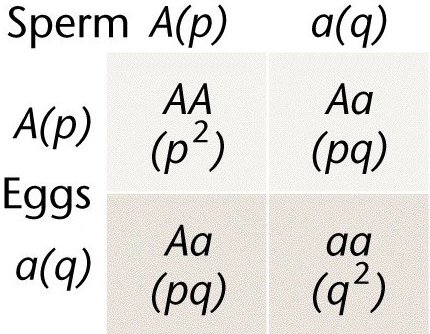

So: f (AA)
=
f(A) x f(A) = p2
f (Aa) = [f(A) x f(a)] + [f(a) x f(A)] =
pq + qp = 2pq
f (aa) = f(a) x f(a)
= q2
|
|
|
|
|
|
|
|
|
|
|
|
|
|
|
|
|
|
|
|
|
|
|
|
|
|
|
|
|
|
|
|
|
|
|
|
|
For the human ABO blood group locus with three alleles, we know:
|
|
|
|
|
|
|
|
|
|
|
|
|
|
|
|
|
|
|
|
|
|
|
|
|
|
|
|
|
|
|
|
|
|
|
|
|
|
|
For a locus with
two alleles
Ho = f(Aa) = observed
heterozygosity
He = 2pq =
2q(1-q) = 1 - q2 expected
heterozygosity
He is the probability that two alleles chosen at random from the population will be different
For a locus with three
alleles
Since p + q + r = 1
The trinomial expansion gives (p + q + r)2
=
p2 + 2pq + q2 + 2qr + r2
+ 2pr = 1
He = 2pq + 2pr + 2qr = 1 - (p2 + q2 + r2)
In general, for a locus
with multiple alleles
n
He = 1 - ![]() (qi)2
for n alleles
(qi)2
for n alleles
i=1
where qi = freq. of i th allele of n
alleles at a locus
In the ABO case: He = 1 - (0.42
+ 0.12 + 0.52) = 0.42